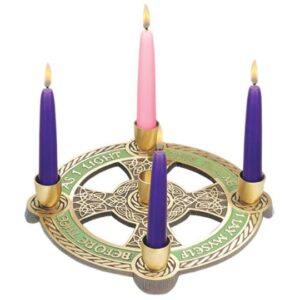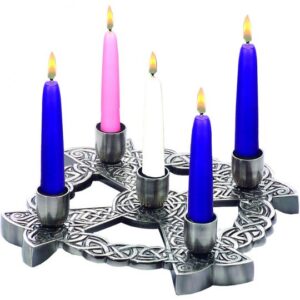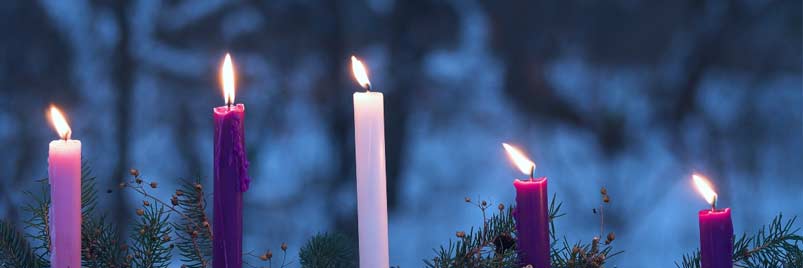The Advent wreath, or Advent crown, is a Christian tradition that symbolizes the passage of the four weeks of Advent in the liturgical calendar of the Western church. It is traditionally a Lutheran practice, although it is celebrated in many Christian denominations.
In 1893, a Lutheran minister fashioned the first Advent wreath out of a wagon wheel, placing twenty small red candles and four large candles in the ring. The red candles were lit on weekdays and the four white candles were lit on Sundays.

Today we use a circle of evergreens, or metal, and four to five candles.
Often, the first, second, and fourth candles are purple; the third candle is rose-colored. Sometimes all the candles are red; in other traditions, all four candles are blue or white. Occasionally, a fifth white candle is placed in the middle and is lit on Christmas Day to celebrate Jesus’ birth. Look here for advent candles.
We are proud to boast the largest collection of advent wreaths. Our collection of five advent wreaths include our most popular Celtic collection of three wreaths. Our “As I light This Flame” advent wreath is made of solid bronze and finished with enameled colors. The interior arms form a Celtic Cross and are decorated with knot work adapted from the book of Kells.
Advent Wreath Symbolism
- Evergreen wreath (symbolizing God’s never ending love & eternal life)
- Four candles in the wreath (representing four Christian themes)
- One candle in the middle (representing Christ)
- Holly berries (representing the blood of Christ)
- Pinecones (representing new life in Jesus through resurrection)
The Advent Wreath in Church Liturgy
“It is now, at Advent, that I am given the chance to suspend all expectation…and instead to revel in the mystery.” ― Jerusalem Jackson Greer
The custom of lighting the candles of the Advent Wreath originated in family settings, but now is widespread in public worship, also, and follows four themes, corresponding to the four candles, which symbolize the Light of The World coming through the birth of Christ. The fifth candle is The Christ Candle, and reminds us that He is the Light of the World, shining in dark places and allowing us to live in the Light as we follow Him.

Each week, one more candle is lit, adding more light, until all four are lit the Sunday before Christmas. This four week process allows us to experience darkness, then growing amounts of light as we anticipate the full Light of World, God incarnate, at His birth, when we light the Christ candle (Christmas Eve or Christmas Day).
Different religious groups define the candles differently, but the meaning stays the same. A marriage of Remembrance (Christ’s First Coming) and Anticipation (Christ’s Second Coming).
Over the course of the four weeks, Scripture readings move from passages about Christ’s return in judgment to Old Testament passages about the expectation of the coming Messiah to New Testament passages about the announcements of Christ’s arrival by John the Baptist and the Angels.
Traditional advent themes for the four advent Sundays are:
- Faith
- Hope
- Joy
- Peace
When is Advent?
It is celebrated in the church over four Sundays, following four themes of Advent, from the end of November to Christmas Eve.
Advent this year starts on Sunday, November 29 and ends on Thursday, December 24.
Advent Through The Centuries
While many know that Advent serves as an anticipation of Christ’s birthday, which, of course, is celebrated on December 25th, when we look at church history we see a deeper meaning behind this season on the liturgical calendar.
The Latin word adventus means “coming”, and in more recent church tradition we celebrate Advent as a looking forward to the birth of Christ.
However, if we zoom out on the liturgical calendar we see that after Christmas is the January feast of Epiphany, which is the celebration of God’s incarnation (birth and baptism). Early Christians would spend 40 days in repentance of sins, prayer and fasting to prepare for to celebrate this “coming”.
Fast forward a century to the 6th century, and you see Roman Christians tied Advent to the second coming of Christ, when Jesus returned to judge to world.
It was not until the Middle Ages that the Advent season was explicitly linked to Christ’s first coming at Christmas. And this is how we celebrate it today.
Christian philosopher, Dietrich Bonhoeffer, says it best when he describes the mystery and comfort that Advent season brings to Christian souls: “The celebration of Advent is possible only to those who are troubled in soul, who know themselves to be poor and imperfect, and who look forward to something greater to come.”
Other Ways to Celebrate Advent
An Advent calendar is a special calendar used to count the days of Advent in anticipation of Christmas, especially if you have children in the home.
Invest in a reusable calendar that allows you to fill a cavity (behind a little door to open each day) with a small toy or candy, and watch little hearts fill with wonder and anticipation in the great countdown to Christmas.
